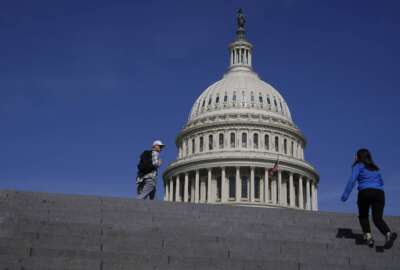Updated 9/27: Resources to help you better understand a government shutdown
Federal News Network has collected documents and articles from the White House, the Government Accountability Office and the private sector to help federal...
With Congress barreling toward a partial government shutdown on Oct. 1 at midnight, Federal News Network has pulled together a host of documents, articles and other useful information for federal employees and contractors.
The goal is to give you one place to help answer questions, learn about the broad impact a government shutdown would have on the government and its people. We will add to and update the resources as they become available.
And, of course, any suggestions from you would be appreciated. Feel free to email us.
OMB’s 2023 FAQs
The Office of Management and Budget issued an 17-page guidance document on Sept. 22 as the government plans for yet another lapse in appropriations. It covers everything from basic principles of an agency operating without funding to contracts and grants to making payments to contractors and grantees.
OMB’s 2019 reopening checklist
This simple two-page checklist issued in January 2019 after the 35-day shutdown helped agencies address six areas. The reminders focused on everything from employees returning to the office to accelerating payments to employees to contract invoices.
Agency contingency plans
Under OMB Circular A-11, each agency is required to develop contingency plans for a lapse in appropriations. OMB currently lists 110 contingency plans covering every large, small and micro agency. Some agencies have updated their plans in the last few weeks, while others haven’t updated theirs since 2018. The oldest plan in OMB’s repository is from 2015.
OPM’s December 2021 shutdown furlough guidance
The Office of Personnel Management developed specific guidance for agency human resources managers to prepare for a shutdown. This 51-page document covers everything from working during a lapse in appropriations to employee assistance to labor management implications. It also provides sample shutdown notices agencies can send to employees.
GAO’s report on government shutdown and contingency planning
The Government Accountability Office found in a June 2020 report that the four agencies it looked at — Customs and Border Protection, the IRS, the International Trade Administration and the Office of the U.S. Trade Representative — had some, but not all internal controls in place to manage the shutdown. GAO made 14 recommendations for these four agencies to improve contingency plans, document shutdown procedures and improve controls for physical and virtual workspace access during a shutdown.
GAO blog post on continuing resolutions
GAO wrote in November 2022 that CRs have become the norm over the last decade. There have been 47 CRs between fiscal 2010 and 2022, ranging between 1 to 176 days (just under 6 months). And on three occasions — at the start of fiscal years 2014, 2018 and 2019 — no CR was approved, resulting in a shutdown.
CRS report on shutdowns
The Congressional Research Service updated this report on Sept. 13, explaining the history around shutdowns, providing documents and the impact it has on federal agencies and the nation.
Senate Homeland Security and Governmental Affairs report on the costs of government shutdowns
This report from 2019 by the Senate Homeland Security and Governmental Affairs committee focused on direct costs to federal agency budgets from the 35-day government shutdown in 2018 and 2019. Those costs don’t include economic impacts — only the funds the government spent or went without because of the actual process of shutting down and restarting its operations. The subcommittee surveyed 26 federal agencies and found the last three government shutdowns cost taxpayers nearly $4 billion — at least $3.7 billion in back pay to furloughed federal workers, and at least $338 million in other costs associated with the shutdowns, including extra administrative work, lost revenue and late fees on interest payments. Agencies reported to the subcommittee that the combined total of furlough days during all three shutdowns was about 14,859,144, representing an estimated 56,938 years of lost productivity for those agency employees.
Committee for a Responsible Federal Budget shutdown Q&A
CRFB answered 14 questions about government shutdowns, mostly focused on the average citizen. There are some good tidbits here, including whether a shutdown saves money (it doesn’t), and how is a shutdown different than a default or sequestration.
Bipartisan Policy Center explainer
The not-for-profit think tank put together nine questions and answers to help explain the basics about a government shutdown. One interesting focus area is how would a 2023 shutdown be different from the 2018-2019 and 2013 versions. One way is the current potential partial shutdown would “also affect a number of programs whose multi-year authorization to spend taxpayer dollars expires, including support for farmers and nutrition aid under the farm bill, air traffic control efforts at the Federal Aviation Administration, and the ability to purchase flood insurance through the National Flood Insurance Program.”
Peter Peterson Foundation’s “Four Reasons Why a Government Shutdown is Harmful”
This nonpartisan organization dedicated to addressing America’s long-term fiscal challenges offers high level commentary on why shutdowns are bad for federal employees, federal services and the country as a whole.
Goldman Sachs report on costs of a shutdown
This September essay from the financial institution focuses on four ways a government shutdown harms the nation’s economy. Interesting stat from the report: Federal employees’ pay accounts for about 2% of the country’s gross national product. “A governmentwide shutdown would directly reduce growth by around 0.15 percentage point for each week it lasted, or about 0.2 percentage point per week once private sector effects were included, and growth would rise by the same cumulative amount in the quarter following reopening.”
Copyright © 2025 Federal News Network. All rights reserved. This website is not intended for users located within the European Economic Area.
Jason Miller is executive editor of Federal News Network and directs news coverage on the people, policy and programs of the federal government.
Follow @jmillerWFED






